
Johannes or Jan Luyken (16 April 1649 – 5 April 1712) was a Dutch poet, illustrator, and engraver. [1]

Johannes or Jan Luyken (16 April 1649 – 5 April 1712) was a Dutch poet, illustrator, and engraver. [1]
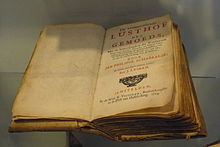

He was born and died in Amsterdam, where he learned engraving from his father Kaspar Luyken. [1] He was a child prodigy. [2]
Luyken married at 19 and had several children, including renowned engraver Caspar Luyken. [1] At age 26 Luyken converted to the Mennonite church, which inspired him to write moralistic poetry. [1]
Luyken illustrated the 1685 edition of the Martyrs Mirror with 104 copper etchings. Thirty of these plates survive and were part of The Mirror of the Martyrs exhibit. [3]
He also published Het Menselyk Bedryf ("The Book of Trades") in 1694, which contains numerous engravings of 17th-century trades by Luiken and his son Caspar (Caspaares).
Joris-Karl Huysmans' anti-hero Des Esseintes in À rebours was an admirer of Luyken's engravings and had prints from his Religious Persecutions hung in his boudoir. He described them as "a collection of appalling plates displaying all the tortures which religious fanaticism has invented." Des Esseintes was enthralled not just by Luyken's graphic depictions but his ability to reconstruct times and places in his works.
![]() Media related to Jan Luyken at Wikimedia Commons
Media related to Jan Luyken at Wikimedia Commons

Daniel Marot or Daniel Marot the Elder (1661–1752) was a French-born Dutch architect, furniture designer and engraver at the forefront of the classicizing Late Baroque Louis XIV style. He worked for a long time in England and the Dutch Republic, where he was naturalised in 1709.

Martyr's Mirror or The Bloody Theater, first published in Holland in 1660 in Dutch by Thieleman J. van Braght, documents the stories and testimonies of Christian martyrs, especially Anabaptists. The full title of the book is The Bloody Theater or Martyrs Mirror of the Defenseless Christians who baptized only upon confession of faith, and who suffered and died for the testimony of Jesus, their Saviour, from the time of Christ to the year A.D. 1660. The use of the word defenseless in this case refers to the Anabaptist belief in non-resistance. The book includes accounts of the martyrdom of the apostles and the stories of martyrs from previous centuries with beliefs similar to the Anabaptists.

Maarten van Heemskerck or Marten Jacobsz Heemskerk van Veen was a Dutch portrait and religious painter, who spent most of his career in Haarlem. He was a pupil of Jan van Scorel, and adopted his teacher's Italian-influenced style. He spent the years 1532–36 in Italy. He produced many designs for engravers, and is especially known for his depictions of the Wonders of the World.
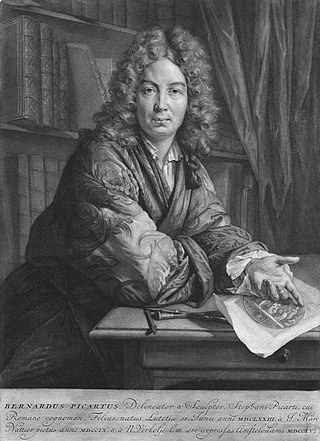
Bernard Picart or Picard, was a French draughtsman, engraver, and book illustrator in Amsterdam, who showed an interest in cultural and religious habits.
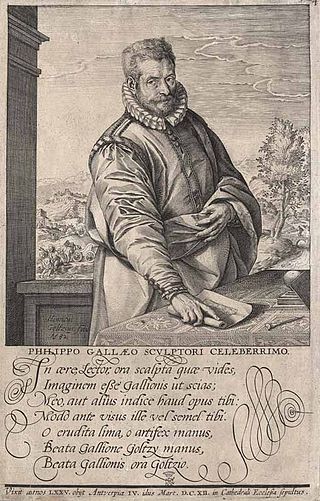
PhilipGalle was a Dutch publisher, best known for publishing old master prints, which he also produced as designer and engraver. He is especially known for his reproductive engravings of paintings.

Het Menselyk Bedryf is an emblem book of 100 engravings by Jan Luyken and his son Caspar published in 1694, illustrating various trades in Amsterdam during the Dutch Golden Age. The majority of the trades shown are from the textile industry (12), followed by marine pursuits (8). The book follows the moralist contemporary style of the then hugely popular emblem books of Jacob Cats, containing a moralistic poem per trade.

Thieleman Janszoon van Braght was the Anabaptist author of the Martyrs Mirror or The Bloody Theater, first published in Holland in 1660 in Dutch.

Jan Thomas or Jan Thomas van Ieperen was a Flemish Baroque painter, draughtsman and printmaker. He was first active in Antwerp where he worked in the workshop of Rubens. He later became court painter at the Habsburg court in Vienna. He is known for his portraits of the rulers of Austria as well as for his pastoral, mythological and religious scenes.

Jan Peeters the Elder or Johannes Peeters was a Flemish Baroque painter and draughtsman. He is known for his seascapes often depicting stormy seas and shipwrecks as well as for his topographical drawings, many of which were engraved by contemporary printmakers and published by the Antwerp printers.

JoannesMeyssens was a Flemish Baroque painter, engraver, and print publisher.
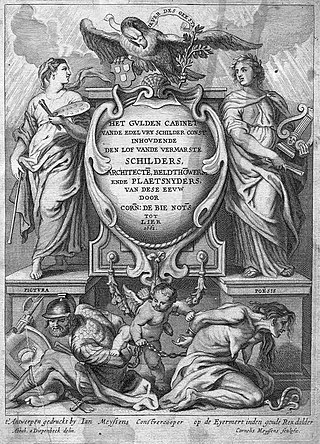
Het Gulden Cabinet vande Edel Vry Schilder-Const or The Golden Cabinet of the Noble Liberal Art of Painting is a book by the 17th-century Flemish notary and rederijker Cornelis de Bie published in Antwerp. Written in the Dutch language, it contains artist biographies and panegyrics with engraved portraits of 16th- and 17th-century artists, predominantly from the Habsburg Netherlands. The work is a very important source of information on the artists it describes. It formed the principal source of information for later art historians such as Arnold Houbraken and Jacob Campo Weyerman. It was published in 1662, although the work also mentions 1661 as date of publication.

Gaspar Bouttats the Elder or Gaspard Bouttats the Elder was a Flemish printmaker and engraver of the Baroque period.
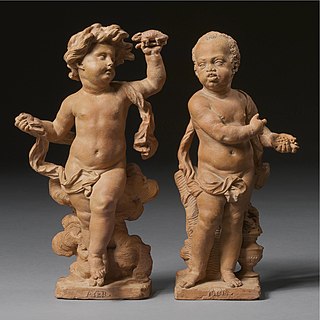
Jan Claudius de Cock was a Flemish painter, sculptor, print artist and writer. De Cock produced both religious and secular sculpture on a small as well as monumental scale. De Cock completed many commissions in the Dutch Republic. He worked on decorations for the courtyard of the Breda Palace for William III, King of England, Ireland, and Scotland and stadtholder. He is credited with introducing neoclassicism in Flemish sculpture. He was a prolific draughtsman and designed prints for the Antwerp publishers. As a writer, he wrote a poem about the 1718 fire in the Jesuit Church in Antwerp and a book of instructions on the art of sculpture.

The Great Theatre of Dutch Painters and Paintresses, or De groote schouburgh der Nederlantsche konstschilders en schilderessen, as it was originally known in Dutch, is a series of artist biographies with engraved portraits written by the 18th-century painter Arnold Houbraken. It was published in three volumes as a sequel to Karel van Mander's own list of biographies known as the Schilder-boeck. The first volume appeared in 1718, and was followed by the second volume in 1719, the year Houbraken died. The third and last volume was published posthumously by Houbraken's wife and children in 1721. This work is considered to be a very important source of information on 17th-century artists of the Netherlands. The Schouburg is listed as one of the 1000 most important works in the Canon of Dutch Literature from the Middle Ages to today.

Antoon van der Does or Antoni van der Does was a Flemish engraver and print maker who was active in Antwerp. He is mainly known as a reproductive artist.

Franciscus van der Steen was a Flemish painter and engraver who was active in Vienna. He is now mainly known for his reproductive prints after master paintings and various publications containing portraits of prominent persons. No known paintings are currently attributed to him.
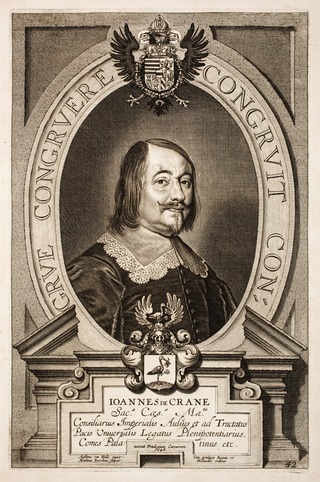
Mattheus Borrekens or Mattheus Borkens was a Flemish engraver, printmaker and draughtsman. He was a reproductive artist and worked on some important publications in the Southern Netherlands. He mainly treated Christian religious subjects and portraits.

Lambert Bidloo, of Amsterdam, was by religion, a Zonist Mennonite, by profession, an apothecary and botanist and by passion, a man of letters and translator. After a solid education in classical letters and a period of apprenticeship, Lambert joined the apothecaries' and surgeon's guild overseeing standards and education at the Collegium Medicum. In 1688, he became the director of this institution, and, along with associates and collaborators, botanist Jan Commelin and anatomist Frederik Ruysch he had a hand in its herbalist Hortus Medicus flowering into the global Hortus Botanicus (Amsterdam) of today. His various learned works in Latin and Dutch deal with plants, with Mennonite religious issues and with different historical themes, contemporary, biblical and literary. Among these Bidloo is best known for the curious Panpoeticon Batavum,, a figurative and visual poet's gallery of Golden Age Dutch literature. This he produced as a joint undertaking with the noted artist and art historian Arnold Houbraken who was then also launching The Great Theatre of Dutch Painters,.

Market of Goa is Plate 5 in Jan Huyghen van Linschoten's Itinerario. The plate depicts the market in Goa, a region on the southwestern coast of India that was the center of maritime trade in Portuguese Asia. Itinerario is a book that includes detailed descriptions and thirty-six engravings of Jan Huyghen van Linschoten's observations of Goa and other Asian cities and islands.
Caspar Luyken was a Dutch illustrator and engraver. He was the son of Jan Luyken with whom he collaborated extensively.